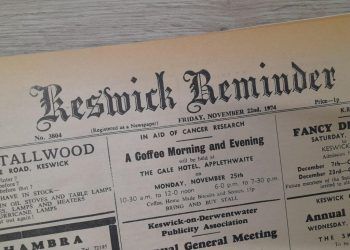
Nobbut Laiking, by Ross Brewster
I’m willing to bet that 99 per cent of us who drive have, at some point, found ourselves dangerously dazzled by these fancy LED lights that are fitted to many vehicles.
When I started driving my first vehicle had a switch on the dashboard which, when turned, sent an orange arrow out from the side to tell people I was turning right. It wasn’t even lit.
We’ve come a long way in road safety since then. Air bags, seat belts, anti-drink driving campaigns, bans on mobile phones being used at the wheel. But as one hazard is countered, another crops up. In this case these appallingly bright headlights whose effect is amplified on roads around this area with their bumps and hollows, twists and turns.
Don’t blame the older drivers for having less than razor sharp eyesight. I know plenty of elderly people who no longer drive at night. Some would like to drive older people off the roads altogether by demanding regular driving tests and eyesight examinations. The Government can’t cope with the test backlog now.
Contrary to popular belief we’re not all Mr Magoos. There are 5.6 million drivers over the age of 70 and I would feel a darned sight safer with them than some young bloods in their souped up motors.
But it’s not just the oldies. Research published by the RAC in March 2022 found that 89 per cent of drivers thought the lights were too bright and 88 per cent said they had been dazzled by them.
There are a variety of lights in use. What’s needed are realistic standards that everyone has to follow. If so many people like me say it’s dangerous and that people are getting scared of driving at night, then this should be the next safety step.
Woolie thinking
No, no, not Woolies. It would be there for ever, a legend of the British high street.
It’s 16 years since our local Woolworths closed. People were in shock. Staff were in tears. Shoppers were in tears. Amid all the changes in retail, the rise of online sales, the credit crunch, we all thought Woolies would be the great survivor. We were wrong. Within weeks of the decision being announced it was gone.
Our Keswick Woolies was store number 938 in the company’s firmament in the British Isles when it opened in 1956. It was more than just a store. Its pick’n’mix sweets were favourites with youngsters and you could buy just about everything from towels to fishing tackle.
Ours had a car park out back and it was a shortcut through the store to get to the Market Square. Moreover, it was a useful refuge when it rained. You invariably came out of Woolies having bought some item.
Will we ever see it back in our town centres? If we do, then it will be the German version, Woolworth without the final “s.”
There is talk of Woolies making a comeback. The chief executive officer of Germany’s Woolworth has refused to rule out such a move “in principle”. He said it was remarkable how a brand with no actual shops had remained such a beloved part of our society.
Woolworths was very much a flagship for a time when shopping had a human touch. The staff worked there a long time and people knew them by name. It was the sort of place where you met up with friends. “See you in Woolies,” we’d say. Most of us had never ordered as much as a pair of socks online when it closed in December 2008. Amazon was still a question in our GCE geography exam papers.
Of course one problem is that to breathe new life into our old pal you would need large retail space in town centres. Our former Woolies is now one of the many outdoor shops in the Lake District. There are obstacles in the way of a nostalgic comeback — but wouldn’t it just be the “Wonder of Woolies” if it were to happen.
What’s the appeal of XL bully dogs?
Can someone explain this to me? Of all the dogs in all the world, why would anyone want to spend money acquiring an XL bully dog?
The Government, from the 1st of this month, brought in sweeping new laws banning unregistered bully dogs. Police have the power to seize them and owners could face unlimited fines and a criminal record. They say XL bullies have been ”disproportionately involved” in the rising number of dog attacks.
More than 30,000 dogs have been registered, but the RSPCA think the actual number may be as many as 50,000. And of course there will be exceptions. Bully dogs that are sweetness and light. Cute family pets.
Yes, they need to be properly trained and some owners point out that any dog, large or small, can be badly behaved if owners do not take responsibility.
But there are hundreds if not thousands of dogs needing a home that aren’t potential killers. If people are so fond of dogs, why not give one of those a home rather than keep a dog that, fairly or not, has an aggressive reputation?








